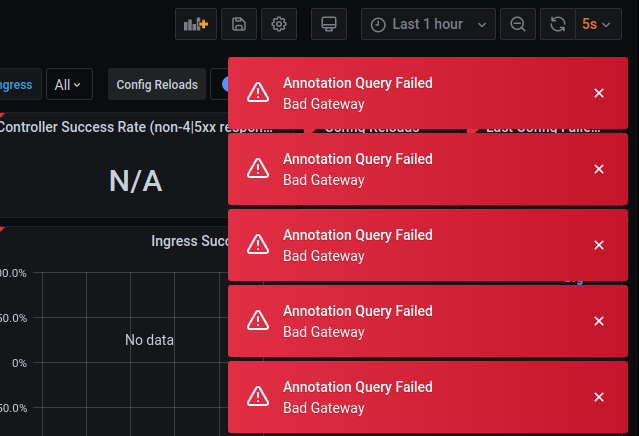Notes
Grafanas helm chart offers so many configuration options and its not easy to keep track of them all. Many options exclude each other and it is not immediately obvious.
For a deeper dive the helm charts

 values.yaml
is a highly recommended read. As with all helm charts this chart is installed by default before all other
customizations are installed.
values.yaml
is a highly recommended read. As with all helm charts this chart is installed by default before all other
customizations are installed.
Depending on the installation settings this chart also deploys sidecars e.g. helper containers that are responsible
for downloading dashboards.
Here are some installation snippets for the record which support installation of dashboards with a ConfigMap.
However this incompatible with configuring installation of dashboards from the grafana website in the same
installation script. (dashboards - section in datasource-dashboards.yaml must be omitted [as in values.yaml])
# works only with
# -- set sidecar.dashboards.enabled=true
#kubectl -n grafana create cm grafana-dashboard-nginx-performance --from-file=dashboards/nginx-request-handling-performance-2m.json
#kubectl -n grafana label cm grafana-dashboard-nginx-performance grafana_dashboard=nginx-performance
#kubectl -n grafana create cm grafana-dashboard-nginx --from-file=https://raw.githubusercontent.com/kubernetes/ingress-nginx/master/deploy/grafana/dashboards/nginx.json
#kubectl -n grafana label cm grafana-dashboard-nginx grafana_dashboard=nginx
Troubleshooting
Grafana pod not starting
Unfortunately there is not always a very useful error message available. But there are a couple of common problems to track first.
Pod keeps pending forever
Watching pod status kubectl get po -n grafana --watch keeps pending state:
NAME READY STATUS RESTARTS AGE
grafana-7bc8fcd968-8d87b 0/1 Pending 0 46s
Describing pod kubectl describe po -n grafana gives lots of details. Read the tail Events first:
...
Events:
Type Reason Age From Message
---- ------ ---- ---- -------
Warning FailedScheduling 14s (x3 over 75s) default-scheduler running "VolumeBinding" filter plugin for pod "grafana-7bc8fcd968-8d87b": pod has unbound immediate PersistentVolumeClaims
Double check storage class name and if the claimed storage is available. Test the  nfs storage provider for availability.
nfs storage provider for availability.
Pod keeps crash-looping
Watching pod status kubectl get po -n grafana --watch keeps crash looping:
NAME READY STATUS RESTARTS AGE
grafana-7bf7ff8644-p6ttj 0/1 Init:Error 0 5s
grafana-7bf7ff8644-p6ttj 0/1 Init:1/2 1 6s
grafana-7bf7ff8644-p6ttj 0/1 Init:Error 1 7s
grafana-7bf7ff8644-p6ttj 0/1 Init:CrashLoopBackOff 1 8s
grafana-7bf7ff8644-p6ttj 0/1 Init:1/2 2 21s
grafana-7bf7ff8644-p6ttj 0/1 Init:Error 2 22s
grafana-7bf7ff8644-p6ttj 0/1 Init:CrashLoopBackOff 2 36s
A typical reason for this error scenario is that the grafana can’t load the required dashboards. If only one dashboard cannot be loaded startup will fail.
From the datasource-dashboards.yaml in the dashboard section remove one by one and reinstall. This is a sample configuration with only one dashboard:
...
dashboards:
prometheus:
grafana-node-exporter:
# Ref: https://grafana.com/dashboards/11207
gnetId: 11207
datasource: Prometheus
Grafana ‘Bad Gateway’
If Grafana is up and running but you don’t see any metrics

In this case the data flow from prometheus to grafana is not properly configured or does not work. Possible reasons are
- Prometheus is not installed. -> Check
 Prometheus
Prometheus - DNS not enabled. We enabled
microk8s enable dns ...during the first installation steps.
Check its availabilitymicrok8s status.
If DNS is enabled follow the Debugging DNS resolution
Debugging DNS resolution
In still not succesfull check the ClusterIp of the prometheus-serverkubectl get svc -n prometheus:NAME TYPE CLUSTER-IP EXTERNAL-IP PORT(S) AGE prometheus-kube-state-metrics ClusterIP 10.152.183.197 <none> 8080/TCP 47h prometheus-node-exporter ClusterIP None <none> 9100/TCP 47h prometheus-server ClusterIP 10.152.183.235 <none> 80/TCP 47hIn this example its
10.152.183.235. Now editdatasource-dashboards.yamland replace in thedatasourcesection:
url: http://prometheus-server.prometheuswithurl:http://10.152.183.235.
NOTE that this temporary fix needs to be checked each time Prometheus is reinstalled.
Installation response message
Sometimes helms install repsonse messages are not accurate.
Just as with regular configuration templates the response is under full
control of the chart developers and its output is rendered by

 NOTES.txt.
NOTES.txt.
In charts with many configuration options it can be challenging to render a proper response message. In this case
the admin.existingSecret and its other variables are not considered.
It should either not be prompted because credentials are provided or it should read
kubectl get secret --namespace grafana grafana-creds -o jsonpath="{.data.admin-password}" | base64 --decode ; echo
